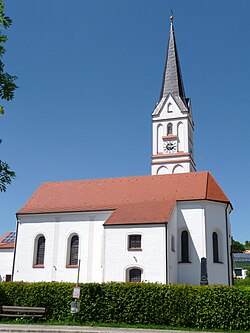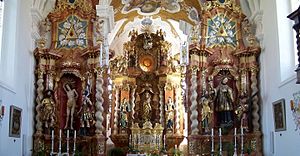St. Sebastian (Furth)
The Roman Catholic parish church of St. Sebastian in Furth near Landshut is a late Gothic hall church from the 15th century, which was converted to Baroque style in the 18th century . The rich interior is kept in the Rococo style. The church is a monument of the Bavarian State Office for the Preservation of Monuments and a cultural asset protected under the Hague Convention .
history
The history of the parish church is closely interwoven with that of the neighboring Furth Castle . The church was built around 1480 by the then owners of the Hofmark , the aristocratic Kärgl family. The builder is likely to be assigned to the Landshut construction works; it could be Peter Westermeier, who also built the St. Ulrich branch church in Gisseltshausen near Rottenburg . In 1741 the church was redesigned in Baroque style by the lords of the royal court from the Lodron family . The furnishings in the splendid rococo style have been preserved to this day. In 1965 the church was renovated inside and in 1978 outside . The last interior and exterior renovation was completed in 2004.
architecture
Exterior construction
The parish church is surrounded by a cemetery . At the southern entrance to the cemetery there is a gate with niches in which there are figures of Saints Francis , Sebastian and Johannes Nepomuk . The hall church has a retracted choir with two bays and ends in three octagonal sides. Like the four-storey choir flank tower with a pointed helmet, which is attached to the north , it still comes from the original Gothic building. The upper three tower floors are structured by pointed arches. A pointed helmet over four triangular gables forms the upper end . The nave has three window axes . The window openings were originally ogival, but have been changed to be rounded . In addition, there is a structure using weak pilaster strips . There are weak, late Gothic triangular struts on the outside of the choir . A large cemetery cross is attached outside at the end of the choir . The sacristy is attached to the south of the choir. On the west side there is a vestibule accessible from the north and south, which contains the portal and the access to the west double gallery.
inner space
In the choir there are late Gothic, bevelled wall pillars and pointed arches with late Gothic vaults with stitch caps . The ribs are chipped off, the consoles have been changed. On both sides of the presbytery there are oratories with curved parapets . In the nave there is a barrel vault with stitch caps that rests on pilasters . The choir arch has been changed to a round arch and also rests on pilasters.
Furnishing
Most of the furnishings come from the renovation around 1741. It is kept in the rococo style with strong baroque echoes.
Ceiling paintings and stucco
The interior is extremely rich with ceiling paintings and stucco in the Rococo style. The main painting in the choir is surrounded by a curly stucco frame and shows a representation of Maria Immaculata . The smaller paintings in the stitch caps show the four evangelists . The ceiling paintings in the nave show scenes from the life of the church patron Sebastian . In the vaults are allegorical representations of Justitia , Sapientia , Sobrietas and Fortitudo . Saints and other allegories are depicted in the stab cap . The ceiling paintings were created around 1741.
The ceiling stucco is equally noteworthy for a country church. The predominant motif is bandwork with grids in the colors white, pink, blue, green and yellow. A pleasant stucco drapery is arranged around the choir arch . On the parapet of the upper west gallery there are stucco coats of arms with inscriptions. Like the ceiling paintings, the stucco was created around 1741. The stucco on the parapets of the oratorios may have been made later; they are in the style of the late rococo.
Altars
The high altar has a stately structure supported by four winding columns. Instead of an altar panel, there is a life-size linden wood figure of the Mother of God with Child from around 1510/20, who holds a figure of the baby Jesus in both hands . The side figures of Saints Barbara (left) and Katharina (right) are assigned to the time the altar was built around 1741. In the altar extension with four winding pillars there is a Marian monogram and a figure of God the Father on a cloud with an orb and scepter, which are surrounded by four angel figures.
The two side altars each have a structure supported by two winding columns and two side figures. On the north side altar, instead of an altar sheet , there is a Baroque figure of St. Sebastian, including a high relief-like , wooden group of the Lamentation of Christ . The latter is an excellent, late Gothic work and is assigned to the time around 1480. The side figures represent Saints James (left) and Florian (right). On the south side altar there is a wooden figure of Saint Aloisius , including a wooden group of the Holy Family with John the Baptist, rich in figures . The side figures represent Saints Paul (left) and Andrew (right).
Other equipment
The rococo pulpit also comes from the time the church was rebuilt. The polygonal pulpit contains winding columns and, like the sound cover , is decorated with inlay work . The confessionals have shell work in the style of the early Rococo. The rococo cheeks are decorated with bands and shells. In addition, several gravestones , a wooden figure of the scourged Savior and a crucifix with a larger than life body are worth mentioning.
organ
The organ of the parish church of St. Sebastian, which is located on the upper floor of the double gallery , was built in 1920 by Albert Moser from Munich . In 1966, she was of Michael manner of Plattling rebuilt and in this disposition still in operation today. The organ pipes are controlled via electric pocket drawers . Today the instrument comprises eleven registers on two manuals and a pedal . Today's disposition is as follows:
|
|
|
||||||||||||||||||||||||||||||||||||||||||
- Pair : II / I, Super II / I, II / P, I / P
- Playing aids : mezzoforte, tutti, automatic piano pedal, shutter release
Remarks:
- ↑ Transmission from reed flute 8 ′
Bells
The ringing of the parish church consists of the following three bells:
1. Mary Bell
- Portrait of the Mother of God with the inscription: "Holy Mary, Mother of God, protect us!"
- 14 hundredweight , Johann Hahn bell foundry , Landshut 1950
2. Sebastian Bell
- Inscription: "Sacrificed in the war, to defend my homeland, I sound again, in honor of the Most High."
- 7 hundredweight, Johann Hahn bell foundry, Landshut 1922
3. Army soul bell
- Inscription: "I mourn the dead."
- 6 hundredweight, bell foundry Johann Hahn, Landshut 1950
Web links
Individual evidence
- ↑ a b c d e Parish Furth & Schatzhofen: Parish Church of St. Sebastian, Furth . Online at online.pfarreifurth.de; accessed on May 9, 2020.
- ↑ a b c Parish Furth: Parish Church Furth . Online www.furth-bei-landshut.de; accessed on January 31, 2016.
- ↑ a b c d e f g Anton Eckardt (Ed.): Art monuments of the Kingdom of Bavaria - District Office Landshut. Oldenbourg, Munich 1914, pp. 96-100 ( digitized version ).
- ↑ Bavarian organ database online
Coordinates: 48 ° 35 '24.2 " N , 12 ° 1' 30.2" E




